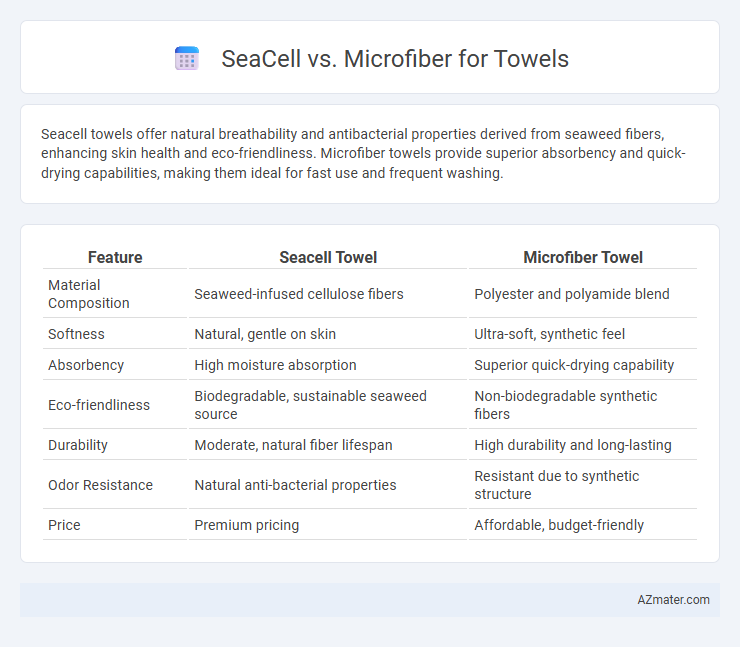Seacell towels offer natural breathability and antibacterial properties derived from seaweed fibers, enhancing skin health and eco-friendliness. Microfiber towels provide superior absorbency and quick-drying capabilities, making them ideal for fast use and frequent washing.
Table of Comparison
| Feature | Seacell Towel | Microfiber Towel |
|---|---|---|
| Material Composition | Seaweed-infused cellulose fibers | Polyester and polyamide blend |
| Softness | Natural, gentle on skin | Ultra-soft, synthetic feel |
| Absorbency | High moisture absorption | Superior quick-drying capability |
| Eco-friendliness | Biodegradable, sustainable seaweed source | Non-biodegradable synthetic fibers |
| Durability | Moderate, natural fiber lifespan | High durability and long-lasting |
| Odor Resistance | Natural anti-bacterial properties | Resistant due to synthetic structure |
| Price | Premium pricing | Affordable, budget-friendly |
Introduction: Seacell vs Microfiber Towels
SeaCell towels combine natural seaweed fibers with cotton, offering enhanced breathability, antibacterial properties, and eco-friendly benefits compared to synthetic options. Microfiber towels, made from finely woven polyester and nylon fibers, provide superior absorbency, quick drying, and durability, making them popular for sports and travel use. Choosing between SeaCell and Microfiber towels depends on preferences for sustainability, softness, and performance characteristics tailored to specific needs.
What is Seacell? Material Overview
Seacell is an innovative fabric blend made from cellulose fibers combined with sustainably harvested seaweed, offering natural skin-soothing properties and enhanced moisture absorption. Unlike microfiber towels composed of fine synthetic polyester and polyamide fibers designed for quick drying and high absorbency, Seacell towels provide unique benefits such as biodegradability and added nutrients from the seaweed content. This eco-friendly material integrates marine biomolecules that promote skin health, making Seacell a premium choice for those seeking sustainable and gentle textile alternatives.
Understanding Microfiber: Composition and Properties
Microfiber towels consist of ultra-fine synthetic fibers, typically a blend of polyester and polyamide, designed to enhance absorbency and drying speed. Their split fiber structure creates a large surface area that effectively traps moisture and dirt, making them highly efficient for cleaning and drying. Microfiber's lightweight, durability, and quick-drying properties distinguish it from natural fibers and contribute to its widespread use in towels.
Absorbency: Seacell Towels vs Microfiber Towels
Seacell towels demonstrate superior absorbency due to their natural fiber composition derived from seaweed and cellulose, which effectively traps moisture while maintaining breathability. Microfiber towels offer rapid absorption and quick-drying properties because of their synthetic microfilament structure, enabling them to hold several times their weight in water. Comparing Seacell to microfiber, Seacell excels in gentle moisture retention and skin benefits, whereas microfiber outperforms in speed of drying and overall water absorption capacity.
Softness and Comfort Comparison
Seacell towels offer exceptional softness due to the incorporation of natural seaweed fibers, enhancing moisture retention and skin nourishment, whereas microfiber towels excel in plushness through ultra-fine synthetic fibers that provide quick-drying properties. While Seacell fabrics feel silky and gentle, promoting comfort for sensitive skin, microfiber materials deliver a smooth, velvety texture that also resists odor buildup. For maximum softness and comfort, Seacell towels are preferred in natural fiber benefits, while microfiber excels in lightweight, durable softness ideal for active use.
Eco-Friendliness: Sustainability of Seacell and Microfiber
Seacell towels are highly eco-friendly due to their biodegradable composition derived from natural seaweed fibers, promoting sustainability through renewable resources and reduced environmental impact during production. In contrast, microfiber towels consist of synthetic materials like polyester and polyamide, which contribute to microplastic pollution and pose challenges in biodegradability and waste management. Choosing Seacell over microfiber significantly reduces ecological footprint, supporting sustainable practices and better ocean health.
Durability and Longevity: Which Lasts Longer?
Seacell towels, infused with seaweed fibers, offer natural durability and enhanced resistance to wear and tear compared to standard microfiber towels. Microfiber towels boast strong synthetic fibers that dry quickly and resist shrinking but tend to lose softness and absorbency after repeated washes. Seacell's unique fiber composition generally results in longer-lasting towels with sustained softness and durability over time.
Skin Benefits: Seacell’s Natural Advantages vs Microfiber
Seacell towels offer superior skin benefits due to their infusion of seaweed fibers rich in antioxidants, minerals, and vitamins that promote skin hydration and reduce inflammation. In contrast, microfiber towels primarily provide high absorbency and quick drying but lack the natural nutrients that support skin health. Seacell's eco-friendly composition enhances skin regeneration and soothes irritation, making it an optimal choice for sensitive or dry skin compared to synthetic microfiber fabrics.
Maintenance and Care Guidelines
Seacell towels require gentle washing with mild detergents and avoidance of bleach to preserve the fabric's natural seaweed properties and softness, while microfiber towels demand low heat washing and air drying to maintain their absorbency and prevent fiber damage. Both fabrics should be kept separate from lint-producing garments to maintain their texture and effectiveness. Proper maintenance ensures durability and retains the towels' respective benefits for skin health in Seacell and quick drying in microfiber.
Conclusion: Which Towel Material is Best for You?
Seacell towels offer superior softness and natural antibacterial properties, making them ideal for sensitive skin and eco-conscious users seeking sustainability. Microfiber towels excel in high absorbency, quick drying, and lightweight durability, perfect for active lifestyles and travel. The best towel material depends on your priorities: choose Seacell for luxury and skin benefits, or microfiber for practicality and performance.

Infographic: Seacell vs Microfiber for Towel
 azmater.com
azmater.com